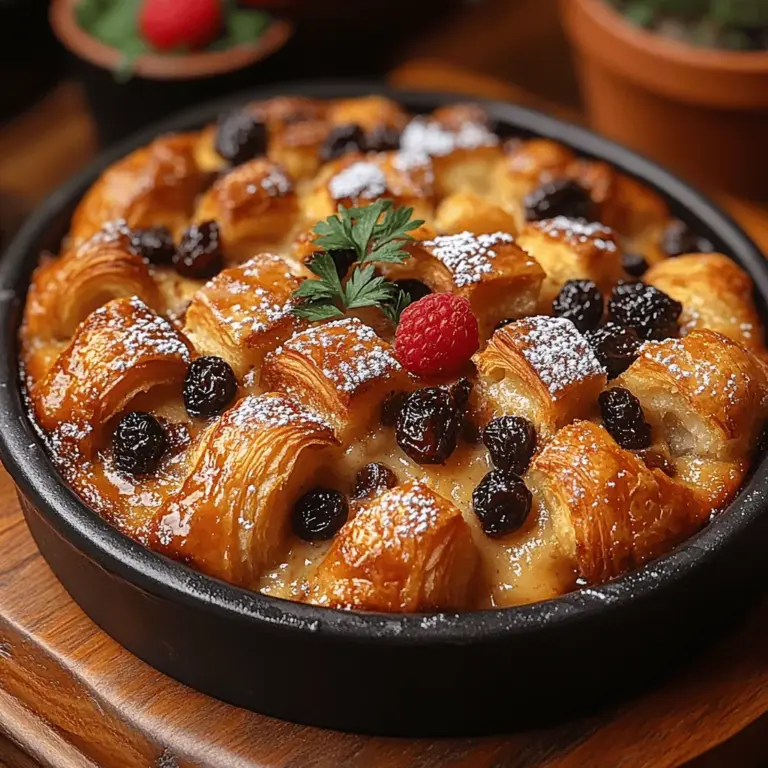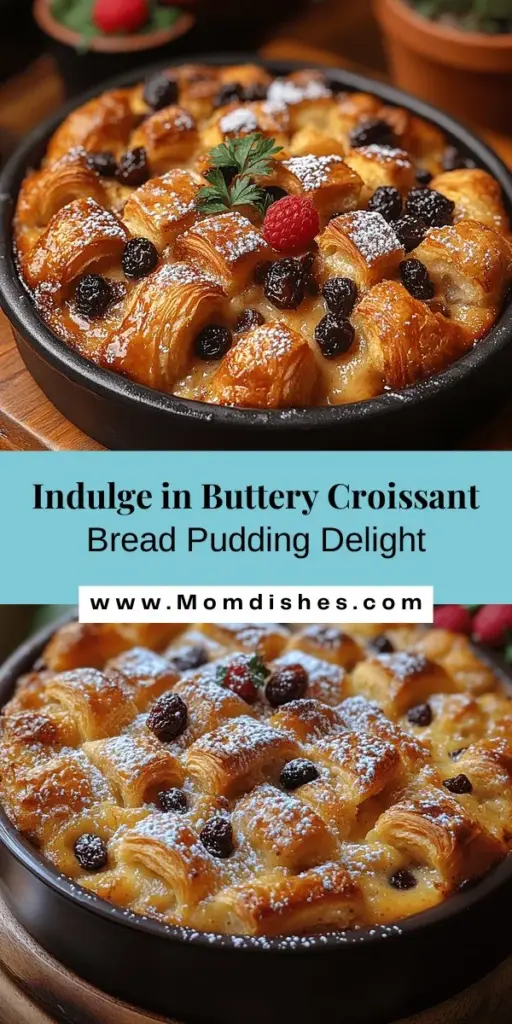Introduction
Bread pudding is a beloved dessert that has warmed hearts and satisfied sweet cravings for centuries. This comforting dish takes stale bread and transforms it into a rich, custardy delight that can be enjoyed warm or cold. While traditional bread pudding typically uses leftover loaf bread, this recipe reinvents the classic by using buttery croissants, offering a unique twist that elevates the dish to new heights. The flaky, rich texture of croissants not only enhances the overall flavor but also adds a luxurious touch that makes this dessert a perfect choice for gatherings and family meals.
Imagine a gathering where the sweet aroma of freshly baked croissant bread pudding fills the air, drawing everyone to the kitchen in eager anticipation. This dessert is not just a feast for the palate; it’s a centerpiece that brings people together, celebrating moments of joy and indulgence. With its creamy custard and the delightful crunch of caramelized edges, buttery croissant bread pudding is sure to impress guests and family alike, making it an ideal addition to brunches, holiday feasts, or cozy weeknight dinners.
Understanding Bread Pudding
What is Bread Pudding?
Bread pudding is a dessert that consists of bread soaked in a custard mixture of milk, eggs, and sugar, often flavored with spices and vanilla. This dish has deep roots in culinary history, believed to have originated as a practical solution for using up stale bread. In essence, it was a way to reduce waste while creating something delicious and satisfying. Over the years, bread pudding has evolved into a beloved comfort food, found in various forms across the globe.
History of Bread Pudding
The history of bread pudding dates back to the 13th century, with its origins traced to Europe. Simple, humble beginnings saw it prepared by layering bread with milk and eggs, allowing it to soak up the flavors before being baked. As time progressed, regional variations emerged, incorporating local ingredients and flavors. In the United Kingdom, for example, bread pudding often features dried fruits and spices, while in France, you might find it enriched with cream and flavored with rum.
In the United States, bread pudding has taken on a life of its own, often served warm with a drizzle of sauce or a scoop of ice cream. Its versatility allows for endless culinary creativity, making it a popular choice for home cooks and professional chefs alike.
Variations of Bread Pudding Around the World
Globally, bread pudding has taken many forms. In Spain, “pudding de pan,” is made with stale bread, milk, eggs, and flavored with cinnamon and lemon. In Italy, “pudding di pane” often incorporates chocolate or fruit, while in the Caribbean, rum is commonly added to enhance the flavor. These diverse interpretations highlight the adaptability of bread pudding, making it a cherished dish across cultures.
Why is Bread Pudding Popular for Using Stale Bread?
One of the primary reasons bread pudding has remained a popular dessert is its practicality. Stale bread is often seen as wasted food, but bread pudding transforms it into a delightful treat. The soaking process allows the bread to absorb the custard, resulting in a moist and flavorful dessert that maximizes the use of ingredients. This resourcefulness resonates with home cooks seeking to minimize food waste while still providing delicious meals for their families.
Why Croissants?
The Uniqueness of Croissants
While bread pudding can be made with various types of bread, using croissants takes this classic dessert to another level. Croissants are known for their flaky layers and buttery flavor, which contribute to a more decadent and indulgent pudding. The texture of croissants creates a delightful contrast between the soft custard and the slightly crisp exterior, resulting in an irresistible dessert that is both comforting and luxurious.
The Importance of Using Day-Old Croissants
For the best results in making buttery croissant bread pudding, it’s essential to use day-old croissants. Fresh croissants are too soft and airy, making them difficult to absorb the custard mixture without becoming overly soggy. Day-old croissants, on the other hand, have dried out slightly, allowing them to soak up the custard while still maintaining some of their structure. This results in a pudding that is creamy yet holds its shape perfectly when baked.
Buttery and Flaky Qualities
The inherent buttery flavor of croissants enhances the overall richness of the bread pudding. As the croissants bake, their flaky layers crisp up, creating a delightful textural contrast that complements the creamy custard. This buttery essence infuses the pudding, making each bite a celebration of flavor and texture. The combination of croissants and custard creates a sophisticated dessert that feels indulgent yet remains simple to prepare.
Ingredients Breakdown
To create the perfect buttery croissant bread pudding, it’s essential to understand the role of each ingredient in the recipe. Here’s a detailed breakdown of the ingredients you will need:
Croissants: Texture and Flavor Profile
Croissants are the star of this recipe. Their delicate, flaky texture and rich buttery flavor set the foundation for this dessert. When selecting croissants, aim for high-quality, freshly baked ones from a local bakery or store. Day-old croissants are ideal, as they have the right balance of moisture and dryness to absorb the custard without becoming too soggy.
Eggs: Binding Agent and Custard Richness
Eggs play a crucial role in this recipe, serving as the binding agent that holds the ingredients together. They provide structure to the bread pudding while also enriching the custard, resulting in a creamy, velvety texture. The eggs help create a custard that is light and airy, ensuring that every bite is indulgent.
Whole Milk and Heavy Cream: Creaminess and Depth of Flavor
The combination of whole milk and heavy cream adds richness and depth to the custard. Whole milk provides a creamy base, while heavy cream elevates the dish with its luxurious texture. This combination ensures that the bread pudding is both moist and rich, enhancing the overall flavor profile.
Granulated Sugar: Sweetness and Caramelization
Granulated sugar is essential for sweetening the custard, balancing the richness of the croissants and cream. As the bread pudding bakes, the sugar caramelizes, creating a beautiful golden crust that adds to the dessert’s visual appeal. This caramelization also enhances the flavor, resulting in a delightful sweetness that complements the buttery croissants.
Vanilla and Almond Extracts: Flavor Enhancements
Adding vanilla and almond extracts introduces a warm, aromatic flavor that enhances the overall taste of the bread pudding. The vanilla adds a classic sweetness, while almond extract provides a subtle nuttiness that pairs beautifully with the croissants. Together, these extracts create a harmonious blend of flavors that elevate the dessert.
Ground Cinnamon: Warmth and Spice
Ground cinnamon brings a warm, inviting spice to the dish, enhancing the flavor profile and adding depth. This warming spice complements the richness of the custard and the buttery croissants, creating a comforting aroma that fills the kitchen as the pudding bakes.
With the ingredients and their roles defined, you are now ready to embark on the journey of creating your own buttery croissant bread pudding. The next steps will guide you through the preparation and baking process, ensuring you achieve a dessert that is both delicious and memorable.
{{image_1}}
Buttery Croissant Bread Pudding: A Culinary Delight
Buttery croissant bread pudding is a decadent dessert that transforms the beloved flaky croissant into a creamy, custard-soaked delight. This dish is not only perfect for utilizing leftover croissants but also offers endless possibilities for customization. By combining rich flavors and textures, this bread pudding is sure to impress at any gathering. Let’s dive into the preparation steps, serving suggestions, and nutritional information for this indulgent treat.
Unsalted Butter: Richness and Moisture
Unsalted butter is a key ingredient in this recipe, providing essential richness and moisture that enhances the overall flavor of the bread pudding. When you bake with unsalted butter, you have complete control over the salt content in your dish, allowing you to adjust it according to your taste preferences. The richness of the butter contributes to the creamy custard, ensuring that every bite of the bread pudding is lusciously satisfying.
Optional Ingredients: Flavor Contributions of Raisins and Dark Chocolate Chips
While the base of our buttery croissant bread pudding is delicious on its own, consider adding optional ingredients like raisins or dark chocolate chips for an extra layer of flavor. Raisins add a touch of sweetness and chewy texture that contrasts beautifully with the custard-soaked croissants. On the other hand, dark chocolate chips melt into the pudding, offering a rich and indulgent flavor that chocolate lovers will adore. Feel free to mix and match these add-ins to create your perfect version of this dessert.
Step-by-Step Preparation Guide
Preheating the Oven: Importance of Temperature Control
Before you begin assembling your bread pudding, it’s crucial to preheat your oven to 350°F (175°C). This step ensures that your dish begins cooking immediately upon entering the oven, preserving the texture and preventing sogginess. A properly preheated oven allows for even cooking and browning, resulting in a deliciously golden top layer.
Preparing the Croissants: Tips for Tearing and Arranging
To prepare the croissants, begin by tearing them into bite-sized pieces. This method not only helps the croissant absorb the custard more effectively but also creates a delightful texture. Arrange the torn croissant pieces evenly in a buttered baking dish, ensuring they are well-spaced to allow for even distribution of the custard later. If you’re using optional ingredients like raisins or dark chocolate chips, sprinkle them throughout the croissant pieces for an even flavor distribution.
Making the Custard: Techniques for Whisking
Next, you’ll need to make the custard mixture. In a large mixing bowl, whisk together the eggs, milk, cream, sugar, vanilla extract, and a pinch of salt until smooth. The key here is to whisk vigorously to incorporate air into the mixture, which contributes to a fluffy texture in the final dish. Ensure that the sugar completely dissolves and that there are no lumps in the mixture. This step is essential for achieving the right consistency in your custard.
Combining Ingredients: Ensuring Even Distribution
Once your custard is ready, pour it evenly over the prepared croissant pieces. Use a spatula or wooden spoon to gently press the croissants down into the custard, ensuring that all pieces are well coated. This step is vital for ensuring that every bite is infused with the rich custard flavor. Allow the mixture to sit for about 10-15 minutes, giving the croissants time to absorb the custard.
Adding Butter: Techniques for Drizzling
Before baking, melt a few tablespoons of unsalted butter and drizzle it over the top of the bread pudding. This technique adds an extra layer of flavor and creates a beautifully golden crust as it bakes. Be generous but don’t overdo it; you want just enough to enhance the dish without making it overly greasy.
Baking Process: Covering with Foil
Place the baking dish in the preheated oven and cover it loosely with aluminum foil for the first 30 minutes of baking. This helps to retain moisture, allowing the custard to set without drying out. After 30 minutes, remove the foil to allow the top to brown and crisp up beautifully. Bake for an additional 15-25 minutes, until the top is golden brown and the custard has set.
Cooling Period: Importance of Letting It Rest
Once baked, remove the bread pudding from the oven and allow it to cool for at least 10-15 minutes before serving. This cooling period is essential as it allows the custard to firm up slightly, making it easier to cut and serve. The resting time also enhances the flavors, allowing them to meld together beautifully.
Serving Suggestions
When it comes to serving your buttery croissant bread pudding, presentation plays a key role. Here are some delightful serving ideas to elevate your dessert experience:
Presentation Ideas for Serving Bread Pudding
To serve, cut the bread pudding into squares or rectangles and place them on individual dessert plates. Consider dusting the top with powdered sugar for a touch of elegance. For an added visual appeal, you can also drizzle a bit of caramel sauce or chocolate sauce over the top.
Optional Garnishes
Enhance the experience by adding optional garnishes. Fresh berries, such as strawberries or raspberries, add a pop of color and a refreshing tartness that balances the richness of the pudding. A dollop of whipped cream or a scoop of vanilla ice cream can add a creamy element, while chocolate sauce can satisfy any chocolate cravings.
Pairing Options
For beverages, consider serving your buttery croissant bread pudding with a warm cup of coffee or a glass of dessert wine, like a late harvest Riesling. Alternatively, a rich hot chocolate can complement the dessert beautifully, particularly if you’ve included dark chocolate chips in the pudding.
Nutritional Information
Understanding the nutritional content of your dessert is essential for mindful indulgence. Each serving of buttery croissant bread pudding typically contains approximately:
– Calories: 350-450 (depending on portion size and specific ingredients)
– Fat: 20-25g
– Carbohydrates: 35-45g
– Protein: 6-8g
– Sugar: 15-20g
While this dessert is indulgent, moderation is key. Enjoying a small serving allows you to savor the flavors without overindulging. Consider pairing it with fresh fruit or a light salad on the side to balance the meal.
Conclusion
Making buttery croissant bread pudding is a joyful experience that yields a comforting and decadent dessert. The transformation of simple ingredients into a rich, custard-soaked dish showcases the versatility of croissants beyond breakfast. This recipe not only allows for creativity through various add-ins but also encourages experimentation with different serving styles.
Whether you choose to keep it classic or explore new flavor combinations, the result is sure to be a crowd-pleaser. So gather your ingredients, embrace your culinary creativity, and enjoy the delightful process of baking this comforting bread pudding. Your taste buds will thank you for this indulgent treat that perfectly encapsulates comfort and satisfaction.


